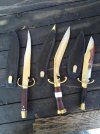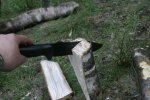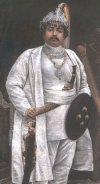- Joined
- Feb 23, 1999
- Messages
- 4,849
I’ve been dropping hints for a couple of years about a special project I was working with HI. The postman delivered the results today and I must say I am most impressed. After extensive communication with HI experts, the three blades in the liberty series were created. They draw from the cultures of Scotland, the United States, and Nepal. The blades are the liberty bowie (L1), the liberty dirk (L2), and the liberty khukuri, (L3). Purists from any of these cultures will complain. What kind of bowie has a cho? What kind of dirk has a coffin handle? What kind of khukuri has a guard? The answer is that these do.
These designs draw heavily on Master at Arms James A. Keating’s insights into fencing with a blade. Years ago I discussed the khukuri with him. While he acknowledged the khukuri’s deadly effectiveness, he didn’t care for them because of their lack of defensive capability. Even Kami Sherpa tacitly acknowledged this when he explained (as quoted on this forum) that the Gurkhas are willing to “trade up.” A finger for an arm, an arm for a head, etc.. This philosophy is alien to the fencer, who strives to make a touch without being touched himself. The liberty series incorporates both offensive and defensive abilities that accommodate a fencer’s approach. You will notice forward curving guards aligned with the cho. Some will have seen such designs before, perhaps in Keating’s crossada, or Bill Bagwell’s Hell’s Belle. (Bagwell has also been heavily influenced by Keating’s theories and techniques.) Those who do not understand the purpose and/or usage of these designs will scoff at them, and that is ok. Those of us who have studied and practiced with them understand. The other thing we understand is that we may have to drop a grand or more to buy a good blade effectively incorporating this type of design.


L1 – (right) A bowie style with a heavier blade for significant chopping and utility use. Capable of backcutting. Draws on the design of the historical Bart Moore bowie.
L2 – (left) A thin-bladed dirk/bowie style oriented a bit more towards fencing. Capable of backcutting.
L3 – (center) A light and quick khukuri modeled on the one-of-a-kind udhaipur that inspired the Gelbu special. The udhaipur was significantly lighter and quicker than most of the GSs. The khukuri shape gives a significant chopping advantage but gives up the backcutting ability.
(Corrected specs added 7/13/13 from Yangdu's post. As always, there may be some variation in the work of different kamis.)

L-1
Overall length 13/3/4''
Weight --18 oz
Spine thickness--1/4''
Blade width --1 3/4''
Brass guard, bolster and buttcap
Satisal wood handle
Leather sheath

L-2
Overall length 17''
Weight --18 oz
Spine thickness--1/4''
Blade width --1 3/8''
Brass guard, bolster and buttcap
Horn handle
Leather sheath


L-3
Overall length 16.5''
Weight --20 oz
Spine thickness--1/4''
Brass guard, bolster, buttcap and tip
Horn handle
Standard leather scabbard

A word on the guard and the cho. The use of forward curving guards was well known in the historical western traditions of swordplay. A Google image search of “Florentine guard” should yield some interesting examples. These could be used to bind an opponent’s blade by the expedient of spiraling around once blade to blade contact occurred. This causes the forward guard at the forte (strong point) of one’s blade to engiage and bind the opponent’s blade, most probably at the foible (weak point) but possibly anywhere. Keating’s insight was that aligning a Spanish notch with the guard often lead to the happy accident of a blade being directed into the notch, creating possibilities for opportunistic breaks, binds, and disarms. My experiments indicate that the cho’s on the liberty series effectively present the same opportunities. For purposes of illustration I requested the assistance of my houseguest, Ms. Kuang Danmei, a taiji sword instructor from Beijing. Ms. Kuang is using a long foil for demonstration purposes, as we were working with a live blade and this provided a safe distance. You can see some illustrative binds in the photos below. The same techniques work with wider blades than foils.


These designs draw heavily on Master at Arms James A. Keating’s insights into fencing with a blade. Years ago I discussed the khukuri with him. While he acknowledged the khukuri’s deadly effectiveness, he didn’t care for them because of their lack of defensive capability. Even Kami Sherpa tacitly acknowledged this when he explained (as quoted on this forum) that the Gurkhas are willing to “trade up.” A finger for an arm, an arm for a head, etc.. This philosophy is alien to the fencer, who strives to make a touch without being touched himself. The liberty series incorporates both offensive and defensive abilities that accommodate a fencer’s approach. You will notice forward curving guards aligned with the cho. Some will have seen such designs before, perhaps in Keating’s crossada, or Bill Bagwell’s Hell’s Belle. (Bagwell has also been heavily influenced by Keating’s theories and techniques.) Those who do not understand the purpose and/or usage of these designs will scoff at them, and that is ok. Those of us who have studied and practiced with them understand. The other thing we understand is that we may have to drop a grand or more to buy a good blade effectively incorporating this type of design.


L1 – (right) A bowie style with a heavier blade for significant chopping and utility use. Capable of backcutting. Draws on the design of the historical Bart Moore bowie.
L2 – (left) A thin-bladed dirk/bowie style oriented a bit more towards fencing. Capable of backcutting.
L3 – (center) A light and quick khukuri modeled on the one-of-a-kind udhaipur that inspired the Gelbu special. The udhaipur was significantly lighter and quicker than most of the GSs. The khukuri shape gives a significant chopping advantage but gives up the backcutting ability.
(Corrected specs added 7/13/13 from Yangdu's post. As always, there may be some variation in the work of different kamis.)

L-1
Overall length 13/3/4''
Weight --18 oz
Spine thickness--1/4''
Blade width --1 3/4''
Brass guard, bolster and buttcap
Satisal wood handle
Leather sheath

L-2
Overall length 17''
Weight --18 oz
Spine thickness--1/4''
Blade width --1 3/8''
Brass guard, bolster and buttcap
Horn handle
Leather sheath


L-3
Overall length 16.5''
Weight --20 oz
Spine thickness--1/4''
Brass guard, bolster, buttcap and tip
Horn handle
Standard leather scabbard

A word on the guard and the cho. The use of forward curving guards was well known in the historical western traditions of swordplay. A Google image search of “Florentine guard” should yield some interesting examples. These could be used to bind an opponent’s blade by the expedient of spiraling around once blade to blade contact occurred. This causes the forward guard at the forte (strong point) of one’s blade to engiage and bind the opponent’s blade, most probably at the foible (weak point) but possibly anywhere. Keating’s insight was that aligning a Spanish notch with the guard often lead to the happy accident of a blade being directed into the notch, creating possibilities for opportunistic breaks, binds, and disarms. My experiments indicate that the cho’s on the liberty series effectively present the same opportunities. For purposes of illustration I requested the assistance of my houseguest, Ms. Kuang Danmei, a taiji sword instructor from Beijing. Ms. Kuang is using a long foil for demonstration purposes, as we were working with a live blade and this provided a safe distance. You can see some illustrative binds in the photos below. The same techniques work with wider blades than foils.


Last edited:


